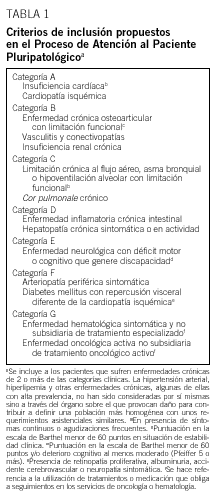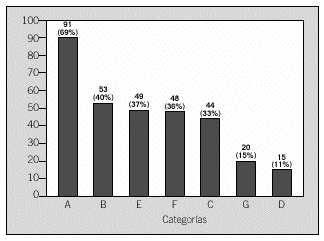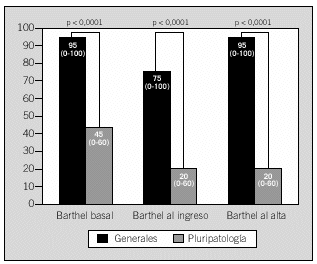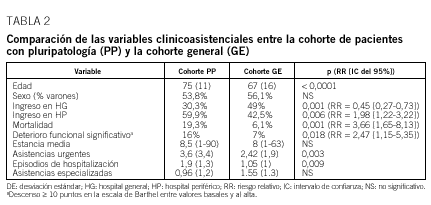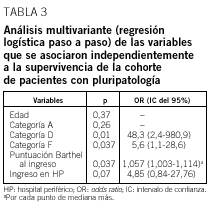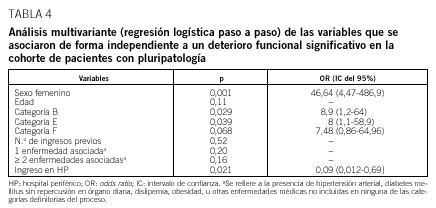Fundamento y objetivo: Analizar la incidencia y características clínicas y evolutivas de pacientes con pluripatología (PP), según la definición propuesta por una comisión de expertos (2 o más enfermedades crónicas distribuidas en 7 categorías). Pacientes y método: Estudio prospectivo observacional en áreas de medicina interna de un hospital de tercer nivel durante junio de 2003. Se estratificó a los pacientes en PP, paliativo (PL) y general (GE) según los criterios de una comisión de expertos. Se analizó la incidencia de PP, procedencia, limitación funcional basal, al ingreso y al alta, evolución y consumo de recursos (atenciones urgentes, programadas, y hospitalizaciones) en los 12 meses previos. Se realizó un análisis multivariante de los factores asociados a la supervivencia y al deterioro funcional significativo (descenso en la escala de Barthel de 10 o más puntos entre basal-alta) en la cohorte de PP. Resultados: Se incluyó a 339 pacientes (cohorte PP: 132; PL: 52; GE: 155). La incidencia global de PP fue 38,9/100 ingresos/mes. En comparación con la cohorte GE, los PP tuvieron mayor edad (media [desviación estándar] 75 [11] frente a 67 [16] años); mayor mortalidad (un 19,3 frente al 6,1%; riesgo relativo [RR] = 3,66; [intervalo de confianza [IC] del 95%, 1,65-8,13]); mayor limitación funcional basal (45 frente a 95), al ingreso (20 frente as 75) y al alta (20 frente a 95); mayor porcentaje de deterioro funcional significativo (un 16 frente al 7%; RR = 2,47 [IC del 95%, 1,15-5,35]); y mayor consumo de recursos en términos de asistencia urgente (3,6 [3,4] episodios frente a 2,4 [1,9]) y hospitalizaciones (1,9 [1,3] frente a 1,5 [1]). La supervivencia se asoció con padecer enfermedad del aparato digestivo (odds ratio [OR] = 48,3 [IC del 95%, 2,4-980,9]) o arteriopatía periférica/diabetes con repercusión visceral (OR = 5,6 [IC del 95%, 1,1-28,6]) y una mayor puntuación Barthel al ingreso. Se asociaron a un deterioro funcional significativo el sexo femenino (OR = 46,6 [IC del 95%, 4,5-486,9]) y padecer enfermedad pulmonar crónica (OR = 8,9 [IC del 95%, 1,2-64]) o enfermedad neurológica con discapacidad (OR = 8 [IC del 95%, 1,1-58,9]). Conclusiones: En áreas de medicina interna la incidencia de PP es elevada. La definición propuesta identifica a una población con especial fragilidad clínica, con una mayor necesidad de recursos hospitalarios y un deterioro funcional importante. La escala de Barthel constituyó un buen identificador común de grupo y un marcador pronóstico independiente.
Palabras clave:
Enfermedades crónicas
Anciano frágil
Comorbilidad
Limitación funcional
Conexión interniveles
Background and objective: Our objective was to assess the incidence and clinical features of patients with numerous disorders--comorbidity patients (CP)--and to clinically validate the CP criteria defined by a panel of experts (patients with 2 or more chronic diseases, distributed into seven cathegories). Patients and method: Prospective observational study of all patients, attended in internal medicine areas of a tertiary teaching hospital, during June 2003. Patients were stratified in 3 cohorts: CP, palliative, and general (GE). Incidence of CP, functional evaluation (at baseline, at admission, and at discharge), and burden of hospital care (by means of urgent and programmed visits, as well as episodes of hospitalization) in the last 12 months were analyzed. A multivariate analysis of predictors of survival and functional deterioration (fall in Barthel's scale >= 10 points between baseline-discharge values) was performed in the CP cohort. Results: 339 patients (CP cohort: 132; palliative: 52; GE: 155) were included. The overall incidence was 38.9/100 admissions/month. CP were older (75 [11] vs 67 [16]); had higher mortality (19.3% vs 6.1%; relative risk [RR]: 3.66 [95% confidence interval [CI], 1.65-8.13]; lower functional ability at baseline (45 vs 95), at admission (20 vs 75), and at discharge (20 vs 95); higher rates of significant functional deterioration (16% vs 7%; RR = 2.47 [95% CI, 1.15-5.35]); and required more burden of hospital care by means of urgent care (3.6 [3.4] episodes vs 2.4 [1.9]), and hospitalizations (1.9 [1.3] vs 1.5 [1]) than GE patients. Chronic digestive/hepatic diseases (odds ratio [OR] = 48.3 [2.4-980.9], peripheric vascular disease/diabetes with visceral involvement (OR = 5.6 [CI 95%, 1.1-28.6]), and better functional ability at admission were associated with survival. Female gender (OR ) 46.6 [CI 95%, 4.5-486.9]), chronic lung disease (OR = 8.9 [CI 95%, 1.2-64]), and neurologic disease with disability (OR = 8 [CI 95%, 1.1-58.9]), were associated with significant functional deterioration during hospital stay. Conclusions: The defined CP criteria were highly accurate in detecting a population of patients with high attention in Internal Medicine areas, high mortality rates, clinical frailty (more need of hospital care), and significant functional deterioration. Barthel's scale identified correctly this group of patients, and was independently associated with survival.
Keywords:
Chronic disease
Frail elderly
Comorbidity
Health services for aged






